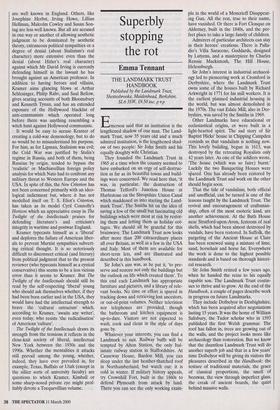Superbly stopping the rot
Emma Tennant
THE LANDMARK TRUST HANDBOOK Published by the Landmark Trust, Shottesbrooke, Maidenhead, Berkshire, SL6 3SW, £9.50 inc. p+p Emerson said that an institution is the lengthened shadow of one man. The Land- mark Trust, now 35 years old and a much admired institution, is the lengthened shad- ow of two people: Sir John Smith and his equally doughty wife Christian.
They founded the Landmark Trust in 1965 at a time when the country seemed to have embarked on an orgy of self-destruc- tion as far as its beautiful towns and build- ings were concerned. We read here that, 'it was, in particular, the destruction of Thomas Telford's Junction House at Hurlestone on the Shropshire Union Canal which maddened us into starting the Land- mark Trust'. The Smiths hit on the idea of saving a few of the small but fascinating old buildings which were most at risk by restor- ing them and letting them as holiday cot- tages. We should all be grateful for this brainwave. The Landmark Trust now looks after more than 200 extraordinary places all over Britain, as well as a few in the USA and Italy. Most of them are available for short-term lets, and are illustrated and described in this handbook.
Sir John's aim was, as he put it, 'to pre- serve and restore not only the buildings but the outlook on life which created them'. To this end each Landmark has appropriate furniture and pictures, and a library of rele- vant books. No time or effort is spared in tracking down and retrieving lost ancestors, or out-of-print volumes. Neither television nor telephones are provided, though the bathroorn and kitchen equipment is up-to-date. Visitors are not expected to wash, cook and clean in the style of days gone by.
Whatever your interests, you can find a Landmark to suit. Railway buffs will be tempted by Alton Station, the only Ital- ianate railway station in Staffordshire. At Causeway House, Bardon Mill, you can sleep under the last heather-thatched roof in Northumberland, but watch out: it is cold in winter. If military history appeals, try Crownhill Fort, built in the 1860s to defend Plymouth from attack by land. There you can see the only working exam- ple in the world of a Moncrieff Disappear- ing Gun. All the rest, true to their name, have vanished. Or there is Fort Clonque on Alderney, built in the 1840s, and the per- fect place to take a large family of children.
Admirers of particular architects can stay in their heroes' creations. There is Palla- dio's Villa Saraceno, Goddards, designed by Lutyens, and a masterpiece by Charles Rennie Mackintosh, The Hill House, Helensburgh.
Sir John's interest in industrial archaeol- ogy led to pioneering work at Cromford in Derbyshire, where the Landmark Trust owns some of the houses built by Richard Arkwright in 1771 for his mill workers. It is the earliest planned industrial housing in the world, but was almost demolished in the 1970s. The vast Edale Mill, also in Der- byshire, was saved by the Smiths in 1969.
Other Landmarks have educational or ecclesiastical origins, or were built in a light-hearted spirit. The sad story of Sir Baptist Hicks' house in Chipping Campden reminds us that vandalism is nothing new. This lovely building, begun in 1613, was destroyed by the retreating Royalists only 42 years later. As one of the soldiers wrote, `The house (which was so faire) burnt.' Luckily the two Banqueting Houses were spared. One has already been restored by the Landmark Trust and work on the other should begin soon.
That the tide of vandalism, both official and unofficial, can be turned is one of the lessons taught by the Landmark Trust. The revival and encouragement of craftsman- ship, often of the most esoteric kind, are another achievement. At the Bath House near Stratford-upon-Avon, festoons of real shells, which had been almost destroyed by vandals, have been restored. In Suffolk, the pargeting of the Ancient House at Clare has been renewed using a mixture of lime, sand, horsehair and horse fat. Everywhere the work is done to the highest possible standards and is based on thorough histori- cal research.
Sir John Smith retired a few years ago, when he handed the reins to his equally capable son. The Landmark Trust contin- ues to thrive and to grow. At the end of the Handbook, a couple of pages describe work in progress on future Landmarks.
They include Dolbelyor in Denbighshire, which has been acquired after negotiations lasting 15 years. It was the home of William Salisbury, the Tudor scholar who in 1593 published the first Welsh grammar. The roof has fallen in, trees are growing out of the walls, and the project looks more like archaeology than restoration. But we know that the dauntless Landmark Trust will do another superb job and that in a few years' time Dolbelyor will be giving its visitors the pleasures described in the Handbook: the texture of traditional materials, the grace of classical proportions, the smell of beeswax, the view through imperfect glass, the creak of ancient boards, the quiet behind massive walls.


































































 Previous page
Previous page